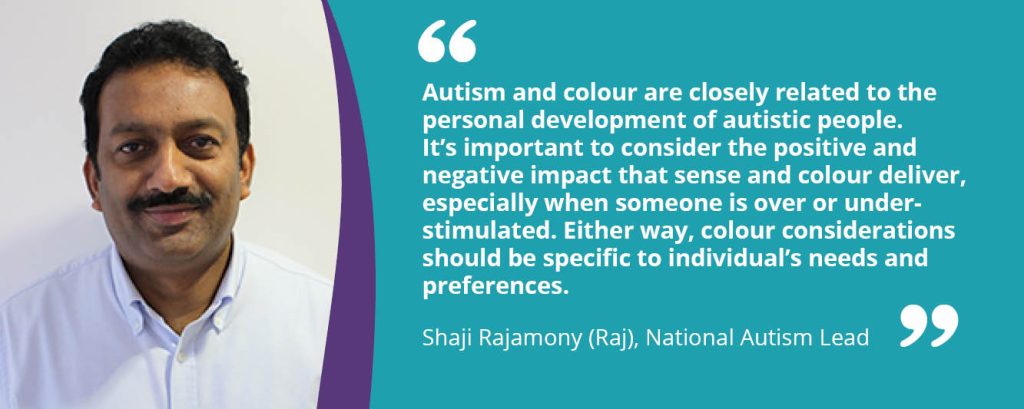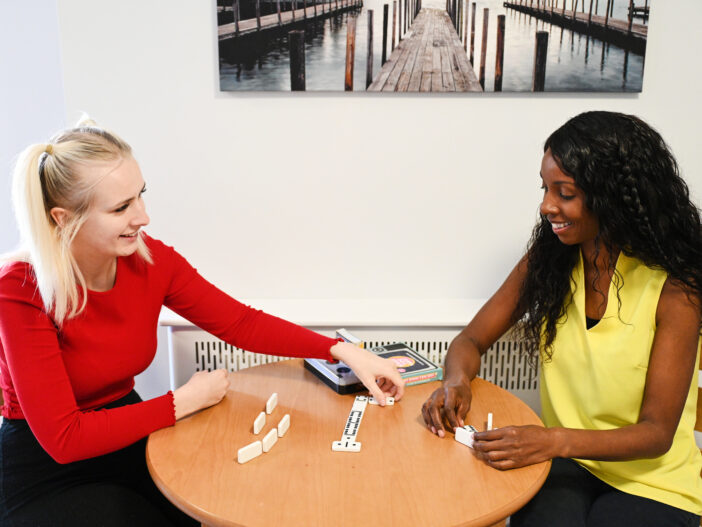Autism and colour: its role in the world of an autistic person
This week is World Autism Awareness Week, a campaign headed by the National Autistic Society to increase awareness and acceptance for autistic people. This year’s chosen theme is ‘colour’.
Voyage Care’s National Autism Lead, Shaji Rajamony (Raj), is an expert in understanding Autism and works closely with the autistic people we support to ensure they live fulfilling and meaningful lives. In this blog, Raj explains the different ways autism and colour are connected and how colour can be used to increase understanding, improve communication within the community and express their feelings and emotions.
Autism – experiencing a world of colour
Without even realising it, our senses are in constant dialogue with our surroundings. Whether that’s the colours of objects around us, the sound of music playing or the breeze from an open window, they are sensations we can experience at the same time.
Many autistic people experience alternative reactions to sensory inputs, including colours, which affect the way they perceive the world around them. Living in a world that does not consider their unique sensory responses can be uncomfortable for autistic people and may trigger unusual, involuntary behaviours that can be aggressive, disruptive, and destructive.

How are different colours perceived?
Neurotypical children are usually drawn to the colours red and blue, which is why so many toys and cartoons are painted in these colours. But what about autistic children?
For years, parents and teachers have observed that children with developmental delay and ASD perceive colours differently. Many researchers have identified a strong attraction to the colour green. A study from 2016 revealed autistic people often dismiss colours – particularly shades of pink and red.
These differences could be due to enhanced sensitivity to external factors or hyposensitivity –low or diminished sensitivity to sensory stimulation. However, hypersensitivity is also a common characteristic of ASD. This means sensory input creates over-stimulation, and noises may be amplified or distorted, or light touching the body can be painful and uncomfortable. These sensations can lead to difficulties with concentration and make bright colours, usually favoured by neurotypical people, feel too harsh.
Managing overstimulation
When an autistic person displays symptoms of hypersensitivity to visual stimulation, it’s extremely beneficial for them to adjust their home environment to avoid ongoing discomfort. Small changes, such as introducing dimmable lights, black-out curtains or simply wearing sunglasses, can combat hypersensitivity.
To accommodate visual sensitivity in shared spaces, muted, matt and harmonious colour schemes could be incorporated into decorative objects, pictures, and textiles.
Colour psychology in Autism
Colours are described in terms of hue, lightness, and saturation and can influence our emotions and behaviours. Identifying hues in childhood is a significant building block in our cognitive development, creating an analytical link between words and visual clues. According to Sensational Colour, red is universally associated with danger, which triggers an emotional and physical reaction, affecting an individual’s actions.
Children are naturally drawn to bright hues as they are more stimulating and easier to see. However, autistic children see hues differently which has varying effects. Bright Autism found that “duller hues with white and grey undertones have a calming effect on kids in this spectrum.” Where most people would describe white as cold and uninviting, autistic people may perceive it as welcoming and comforting.
Colour therapy
Enhanced sensitivity in autistic children may result in specific colour preferences. Their colour preference can be identified at an early age through the introduction of crayons or multi-coloured toys. This preference should be taken into consideration when designing autism-friendly spaces.
For example, overstimulation to certain hues can suppress or restrain impulses and behaviours. A colour that makes one person feel happy may make another aggravated, depending on past experiences.
Colour therapy is a successful method used to support autistic individuals in identifying and managing their moods. Identifying positive colour reactions can increase task performance and reading ability. The use of colours and lights can also improve communication skills and reinforce concepts and ideas.
Synaesthesia in Autism
There’s lots of research on the relationship between Autism and synaesthesia – many of which indicate it’s a common trait in autistic people.
Synaesthesia is when one sense is experienced through another, and this experience varies for each person. Synaesthesia typically starts in childhood and comes in many forms; a taste can have a shape, a word can have a colour, the months of the year may be felt around the body. Some people even experience more than one type of synaesthesia.
In 2007, researchers published a case study about an individual with synaesthesia named Daniel Tammet. He sees numbers in different colours, textures, and shapes. He also has advanced recall, reciting the entire 22,414 digits of the Pi ratio from memory!
While many autistic people experience synaesthesia, it is still considered rare and is difficult to detect. Almost always though, there’s a strong relationship to colour and how this is perceived.
Find out more
Voyage Care’s person-centred approach to autism support ensures all autistic people we support receive the best quality care from specially trained staff and autism experts. For more information on the services we provide, visit our autism support page.

 Views
Views 

